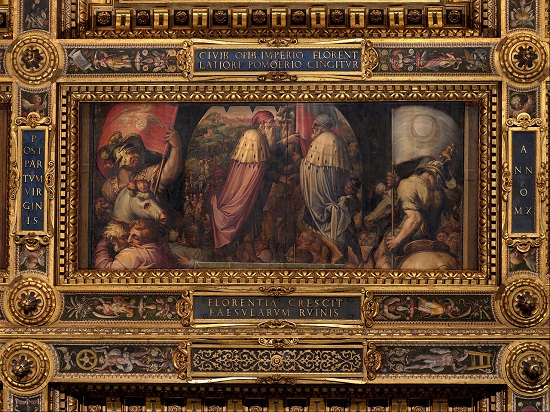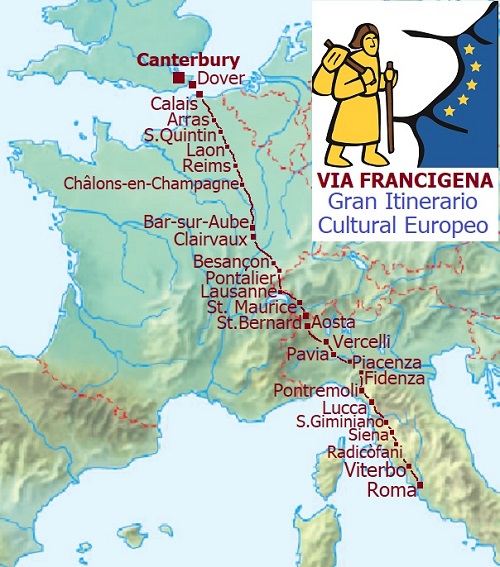Puberty
Municipal autonomy was a privilege given to Florence by Matilda due to the city’s support in her struggle against the emperor. When the Countess died (1115), the new marquis of Tuscany a German count named Rabodo, appointed by Henry V, wanted to break the practice of hereditary succession in Tuscany and moved the capital from Florence, where it had been since 1057 to the fortified town of San Miniato al Tedesco.
He also established an alliance with counts opposed to Florence’s primacy and took a castle at Monte Cascioli that was until then in the possession of the Florentines. In 1120 the Florentines took back the castle and Rabodo was killed defending it.
The next German margrave appointed by the emperor, Conrad of Tuscany favored Lucca and spent his first two years of tenure (1120–1122), in wars with Florence. In 1123 certain captains loyal to the counts of Lucca managed to occupy the castle of Fiesole. The Florentines laid a siege on it and after two long years, the Fiesolani were starved into submission.
Their Etruscan walls were razed to the ground and the leading families of the city were obliged to take up their residence in Florence. The two towns would from now on be considered to be one. That same year (1125) was the year the last Emperor of the Salian dynasty died (Henry V). It is also the year when the first mention of the city consuls, the new ruling body of the city-state of Florence was first recorded.


The 1120s was a period of urbanization for Florence, with people flocking to the city from the country, especially powerful families in the vicinity of the city, and feudal lords, who carried with them the rights to their rural counties.
That wave gave birth to the town’s new noble class, which would serve as the main tank for the city consuls along with the first circle of pre-existing nobles. Given the evidence about the fate of their castles (most of them were razed to the ground), it can be speculated that this was not a voluntary transition for them.



In 1138 we have the first nominal mention of two Florentine consuls representing the city in a council of Tuscan cities (the Roncaglia di Toscana) at San Genesio (where Via Pisana intersected with Via Francigena) where the Tuscan cities tried to establish a common policy against the imperial oppression. It was a time that Florence played a secondary role compared to Lucca, Pisa, and Siena and the feuds between them were still too young.
The Commune was then under the guidance of twelve consuls, prominent figures of a council of about 150 Boni homines and a body of a popular assembly that convened four times per year at the Cathedral of Santa Reparata (later Cattedrale di Santa Maria del Fiore). The connection of the road that crossed the valley of Arno with Via Francigena but most of all the gateway to the sea through the Arno river port set a solid base for the development of commerce.
After 1150 with most nearby castles conquered and the population on the rise, a new class, that of the merchants would accelerate the growth of the city and its economy already booming in the fields of clothing processing and handicraft production.


New populous suburbs started to spring up around the circle of Matilda’s wall in correlation to the gates. The Borgo di Balla where the wool dyers were located, the Borgo de’ Greci, the neighborhood of the Greeks where the traders from the east resided, the Borgo San Jacopo, the Borgo di Porta Santa Maria, etc.
In 1173 the city officially entered the era of growth with the construction of another line of walls that would include the new districts and place the thriving port within its protection. It was an area three times larger than the one before enclosing a population of around 25.000 people.



Antagonism with the rest of the Tuscan cities led to several clashes that were almost every time associated with the delimitation of their territory. That was particularly true in the case of Siena, a city that was also trying to expand its sphere of influence at the expense of smaller towns.
The relations with Pisa however, one of the richest cities in Europe at the time, were not hostile. Florence needed Pisa’s port, at the mouth of the Arno, for its naval commerce so the two cities had established a strong alliance with Florence offering its military support in Pisa’s struggle against Genoa in return for the use of its port, its warehouses and a favorable treatment of Florentine merchants in Pisan ships. With every city acting as a state, however, that was bound to be tested.


Not all Florentines were pleased with the city’s policy. In 1177, two years after the completion of the new wall, a group of families that wanted Florence to join the Imperial camp, started one of many civil conflicts between the nascent Ghibelline (side of the Emperor) and Guelph (side of the Pope) factions of Florence.
The civil conflicts within the boundaries of the city must have accelerated the pace of construction of several defensive towers that were attached to the houses of their owners and offered them protection in case of an attack. By 1180 more than 35 of them were documented.
There were even associations known as consortia, the tower societies that helped their members, the powerful families that owned the tower houses, to organize, proliferate and expand their influence over the city, operating as mini local governments. Most importantly they guaranteed a member’s protection and allied protection during a time of need. Only later, during the 14th century and after a series of transformations (usually larger openings and portals) the towers would lose their defensive role.



In 1182 we have the first concrete proof of the rising power of the merchants with the establishment of their guild the Arte dei Mercanti, Calimala located on the ground floor of one of the towers of the family Cavalcanti overlooking the Mercato Nuovo. At the end of the 14th century, it was relocated to Calimaruzza Street, in a building that still bears the golden eagle effigy, the guild’s symbol.



In 1185, Emperor Frederick Barbarossa, in his sixth and last expedition to Italy, joined forces with the local rural nobility to reduce the power of the Tuscan cities. Florence would be deprived of its territories and the marquisate would be restored with his youngest son Philip at its head.



Shortly after the death of Barbarossa’s successor Henry VI (September 1197), prompted by an initiative of Pope Celestine III, the lords, and bishops of Lucca, Florence, Siena, and Arezzo formed a new alliance known as the Tuscan League which pledged to a common defense against future Emperors. By 1203 the Florentines would regain their lost territories and go even further with the subjugation of the powerful feudal lords of Elsa Valley that gave Florence direct access to the Via Francigena.
A new flow of immigrants from the countryside increased the population and propelled the economy with the supply of cheap labor. Commerce boomed in the absence of the feudal tolls, fueling the circulation and accumulation of capital which in its turn created credit and more growth. Florentine merchants were active from the Levante to the east, to the Flanders on the north, as were their main antagonists from the rest of the Italian cities.



